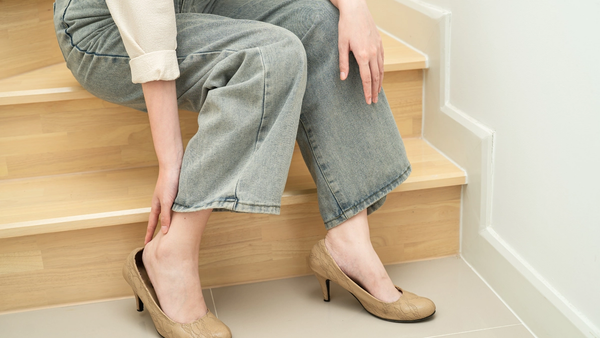Haglunds deformity
Haglund's heel is a condition where the back part of the heel bone has an unusually prominent bony growth. This often leads to pain at the back of the heel and around the achilles tendon, either due to strain on the tendon or as a result of pressure and friction from shoes. The pain can be particularly intense during activity and after periods of rest.
At Dr. Dropin, we have skilled practitioners who can assess your elbow pain and help you receive the appropriate treatment.
See availability
What are you looking for?
Symptoms of haglunds deformity
If you have Haglund's heel, you may experience one or more of the following symptoms:
- Pain on the backside of the heel
- Pain during weight-bearing activities such as standing, walking, and/or running
- Often increased pain when bearing weight after lying down or sitting for a while
- Can affect one or both feet
Haglund's heel is a condition that can develop gradually, and symptoms may vary in intensity. It's crucial to seek professional guidance for an accurate diagnosis and appropriate treatment if you are experiencing these symptoms.
See availability
Treatment
Treatment for Haglund's heel often involves various approaches to achieve specific therapeutic goals. Here are some common treatment methods:
- Pain Relief: Manual techniques such as joint adjustments, massage, and trigger point therapy can help reduce heel pain.
- Increased Flexibility: Specific stretching exercises and techniques can contribute to improving the mobility of the calf and foot.
- Strength Training: Gradual introduction of strength exercises for the muscles in the calf and foot can help reduce strain on the tendon.
- Biomechanical Evaluation: Analysis of running technique and potential adjustments to footwear or insoles to alleviate stress on the Haglund's heel.
- Functional Rehabilitation: Gradually resume running and other daily activities, focusing on restoring optimal function in the foot.
It's important to understand that the treatment for Haglund's heel should be tailored to individual needs and may vary from person to person. A thorough evaluation and close collaboration with an experienced physiotherapist or chiropractor are crucial for developing an effective treatment plan.
See availabilityWhen should you book an appointment?
If you recognize the symptoms above and are experiencing any of the following issues, we recommend seeking professional guidance:
- Pain or reduced mobility that has persisted for more than a week without improvement.
- Severe symptoms that you need assistance in reducing quickly.
- Symptoms that cause you concern or that you believe may be due to more serious conditions.
Remember that early assistance from a therapist can reduce the duration of your issues and contribute to achieving the best possible outcome. You should never worry that your problems are "too small" - we take all types of issues seriously.
See availability
Find the right therapist for your needs
Our therapists have different areas of expertise.
Try our digital advisor and get an immediate recommendation about which therapist can best help you get rid of your heel pain.
Start advisorUse your health insurance
We cooperate with all the major insurance companies, so that you can use your health insurance with us if you have heel pain or other problems.
Read more about how to use your health insurance here
What can you do by yourself?
While treatment for Haglund's heel typically involves professional guidance and therapy, there are several measures you can take on your own to alleviate symptoms and improve the condition:
- Follow recommended exercises: If you've been given home exercises by your therapist, it's crucial to perform them regularly.
- Modify activities: Avoid activities that lead to prolonged worsening of foot pain (more than 12 hours).
- Pain relief: Pain can sometimes be reduced by using an ice pack, heating pad, warm shower, or by gently moving the affected foot.
- Medications: Use over-the-counter pain relievers as directed by healthcare professionals.
If you haven't had the condition assessed yet or have deviated from the treatment plan, it's recommended to consult with healthcare professionals for further guidance.
See availabilityFrequently asked questions about haglunds deformity
Are there long-term consequences of untreated Haglund's Heel?
Untreated Haglund's Heel can lead to chronic pain, reduced mobility, and in some cases, the development of other foot issues.
Are there long-term consequences of untreated Haglund's Heel?
Untreated Haglund's Heel can lead to chronic pain, reduced mobility, and in some cases, the development of other foot issues.
What are the common mistakes people make regarding Haglund's Heel?
Some common mistakes include ignoring the pain, continuing to wear shoes that worsen the condition, and self-treatment without professional guidance.
What are the common mistakes people make regarding Haglund's Heel?
Some common mistakes include ignoring the pain, continuing to wear shoes that worsen the condition, and self-treatment without professional guidance.
Can Haglund's Heel be prevented?
Prevention involves wearing appropriate footwear, avoiding excessive strain, and regular stretching to maintain foot flexibility.
Can Haglund's Heel be prevented?
Prevention involves wearing appropriate footwear, avoiding excessive strain, and regular stretching to maintain foot flexibility.
How is Haglund's Heel diagnosed?
Diagnosis is typically made through a physical examination, X-rays to assess bone structure, and an evaluation of symptoms and medical history.
How is Haglund's Heel diagnosed?
Diagnosis is typically made through a physical examination, X-rays to assess bone structure, and an evaluation of symptoms and medical history.